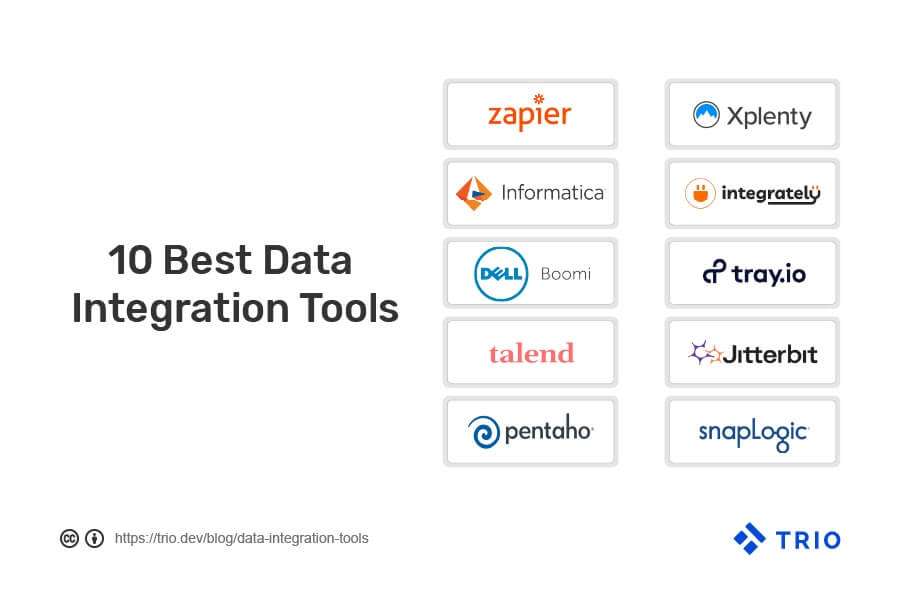Data integration tools empower businesses to reach their full potential. Technology has been helping businesses thrive for millennia, whether mechanical or digital. But data integration tools have the particular ability to unite the most utilitarian of technologies in your toolset.
With data integration, you can save time and boost efficiency for your business. In the process, you can magnify your earnings as well by adopting a more productive means of completing tasks.
Though data integration can branch distinct software systems into a comprehensive ecosystem, the jury is out on which data integration tools are most up for the task.
Here’s a preview of the tools you’ll be learning more about today:
- Zapier
- Informatica
- Dell Boomi
- Talend
- Pentaho
- Xplenty
- Ingrately
- Tray.io
- Jitterbit
- SnapLogic
To find out what the best data integration tools are for 2022, keep reading!
What Is Data Integration?
Data integration defines the synchronization of various digital tools and technologies into a unified and accessible platform.

The primary use case of data integration is to provide actionable business intelligence and insights. In other words, integration solutions enable businesses to use different tools to optimize operations both externally and internally.
For example, many businesses use marketing APIs to integrate data across various marketing tools. Such tools span different needs from lead nurturing to customer retention.
Overall, application programming interfaces (APIs) play a crucial part in data integration as their purpose is to ensure the functionality of interacting software. For this reason, the actual integration process can get quite technical. It’s not as simple as plug-and-play. Though some technologies abstract away the complexity of data integration exactly for this purpose.
As an illustration, ETL is a type of integration that refers to three essential steps — extract, transform, and load — when it comes to data.
ETL is an age-old standard for mass data integration, in which data ultimately gets stored in a data warehouse for historical analysis.
Of course, these days, it’s much more likely that a business will rely on the cloud for data integration.
And marketing automation is often the goal of businesses who choose to employ data integration.
But data integration can also extend to organizing contact records and planning workflows, depending on which systems you plan to integrate with one another.
Either way, data integration remains a fairly technical endeavor. But it is still essential to almost any business operation.
Why Is Data Integration Important?
Data integration is important because it helps businesses scale. Businesses can’t succeed without the proper tools to do so.
Often this means combining your customer relationship management (CRM) platform with marketing operations software or connecting your content management system (CMS) with an email marketing program.
Whichever way, data integration brings about analytics and operations that would otherwise be unavailable to you. And data integration tools make these auxiliary accessaries more accessible than ever before.
At the heart of data integration is collaboration. Besides the mere unification of systems, which technically defines all data integration tools, the figurative significance of integration is much more powerful.
Successful software development teams, for example, are not only technically skilled. They run on communication and collaboration.
When working with non-human tools on a technical project, like data integration tools, communication and collaboration are still imperative.
Data integrations tools — along with the help of APIs — ensure that communication and collaboration are possible and exceedingly useful.
Related reading: Know The Top 7 API Integration Tools
What Are Data Integration Tools?
Now that you know what exactly data integration is, you’ll want to learn a thing or two about data integration tools.
Data integration tools or data integration software sync systems together to improve workflows in business operations.
For instance, to access data from multiple sources such as your business email account, social media network, and customer records, you need data integration. And several data integration tools exist to do just what you have in mind.
Most data integration tools can provide the following benefits:
- Automate routine tasks
- Simplify complex B2B data integrations
- Enable data management from a central hub
- Develop the potential of collected data
Really, the ultimate advantage of data integration tools is their ease of use. Simplification via system connectors can turn monotonous and tedious tasks into outright value generators for your business.
Types of Data Integration Tools
There are several different types of data integration tools — on-premise, cloud-based, proprietary, and open-source. Here’s a quick summary of the type of data integration tools that you can choose from:
➼ On-Premise
On-premise data integration tools take up space on a private cloud or local network. Internal IT typically handles integrations using in-house software. The downside of this model is the cost of maintaining and managing infrastructure alongside your IT department.
➼ Cloud-Based
Cloud-based data integration tools use the cloud to integrate multiple sources of data. For most businesses, cloud technology is the most cost-effective method to meet their data integration needs.
➼ Proprietary
Proprietary data integration tools are enterprise-level and address specific business needs. However, they tend to be more expensive than some small businesses can finance.
➼ Open-Source
Open-source data integration tools have a public source code. Contributors can edit the source code and users have free access to the open-source platforms. This circumvents the need to use proprietary and thereof expensive enterprise solutions.
10 Best Data Integration Tools
Data integrations tools occupy an obscure but thriving market. Although there are dozens of data integration tools, there is some variance in their unique functionality. At any rate, these are the tools that routinely stand out in any analysis.

1. Zapier
Zapier is one of the only data integration tools of its kind. Though this proprietary software is notably expensive, Zapier provides a no-code solution for meeting business needs. The platform comes equipped with several thousand app integrations right out of the box. And Zapier’s user-friendly interface makes it easy as pie to set up and start automating common workflows.
2. Informatica
Informatica is a software development company with a variety of data-related tools. Along with data integration through ETL architecture, data masking, data virtualization, data management, and more.
Informatica PowerCenter is the name of Informatica’s data integration tool. Popular clients such as the U.S. Air Force and Samsung use Informatica PowerCenter for their data affairs.
3. Dell Boomi
Dell Boomi is a cloud data integration tool that comes with nearly 2000 built-in endpoint connections. Over 15,000 customers utilize the service to automate their integrations and reduce the time they spend building customized connections.
In 2020, Boomi was ranked a leader in the 2020 Gartner Magic Quadrant for enterprise integration platforms as a service (iPaaS). The platform comes in second only to Informatica in its “ability to execute.”
4. Talend
Talend takes apart and handles every part of the data lifecycle. This includes data integration, data integrity, data governance, and application and API integration.
Today, Talend is one of the more popular open-source data integration tools. Given its open-source characterization, Talend is best suited for businesses aiming for cost optimization.
5. Pentaho
Pentaho is known for being easy to learn and use. Users can develop ETL tasks with a code-free graphical interface.
The business intelligence of Pentaho permits organizations to access and analyze data from a number of sources across almost any environment with ease.
Pentaho, Hitachi Data Systems, and Hitachi Insight Group are now merged into a platform called Hitachi Vantara.
6. Xplenty
XPlenty is said to feature an intuitive, simple drag-and-drop low-code graphical user interface (GUI) for building secure data pipelines.
The Xplenty platform syncs with over 140 data sources and extends users unlimited 24/7 support. And flat-rate pricing makes this tool even more appealing.
7. Integrately
Integrately sports more than eight million ready automations for over 500 applications. Most of Integrately’s automations are pre-made and you can activate them with just one click.
Users also have the chance to develop integrations from scratch, a customization feature not every data integration tool can provide.
8. Tray.io
Tray.io does not have the same popularity as other tools in this list. Still, its tooling compares to that of Zapier in terms of capability.
The platform emphasizes automation through “clicks-or-code”. In practice, this means users have the option to abandon traditional programming for a more visual interactive apparatus. But when more customization is necessary, you can turn to code to finish the job.
9. Jitterbit
Jitterbit streamlines communication between cloud, on-premise, and software as a service (SaaS) applications.
Artificial intelligence also plays a fundamental part in how the platform operates. Through AI, users can get real-time language translations, speech recognition, and a recommendation engine.
Choose from an extensive library of pre-built templates and workflows in Jitterbit. Create new APIs and connect to external ones. Share your work with others in your organization. These are just a few features of Jitterbit.
10. SnapLogic
SnapLogic Intelligent Integration Platform, or just SnapLogic for short, is a robust data integration tool with self-service functionality.
One of SnapLogic’s most outstanding features is its capacity to integrate with Internet of Things (IoT) devices. No doubt, this takes data integration a step further than most data integration tools would even dream of.
How To Choose the Right Data Integration Tool
Choosing the right data integration tool can be a complicated process. Besides the 10 data integration tools you glimpsed above, there is a growing market of software with the same objective.
There should be no question that data integration is a must. Data integration tools save businesses hundreds of hours of mindless work, work that is necessary but far too repetitive for human intervention.
Thus, APIs and integration come into play. But how exactly they make their mark is up to you.
Some things you should consider when choosing what data integration tool to use are listed below:
‣ Business size
‣ Customization needs
‣ Use cases
‣ Security risks
By far, customizability is the determining factor that leads businesses to choose one tool over another. Therefore, it’s important to pay close attention to what products can serve your custom requirements.
Start Integrating Your Data Today with Trio
Looking for an easier way to enhance your business processes? Trio is a business-to-business (B2B) company that specializes in servicing a variety of software development needs.
Lucky for you, data integration is one of Trio’s strengths. Unlike most data integration tools, Trio relies on its own trained developers to build custom software for you without breaking the bank.
Trio has the right people and the right tools to refine your integration strategy for the better. To learn more about how Trio can help you, chat with Trio now!






